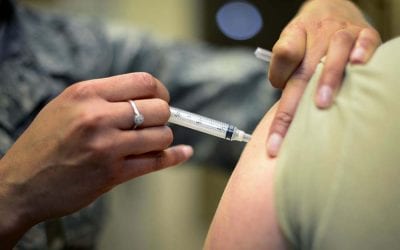
Lady Macbeth had her problems with blood. DSLR (digital single lens reflex camera) owners have their problems with dust on the DSLR’s sensor, where the image is captured.
Is there anything worse, when you get home from vacation, to find a spot on the same location on every photo? On some photos the spot’s on faces, on others, buildings, and on most, it’s exactly where it will hurt your photos the most.
It’s a bane that amateur photographers, new to their DSLRs didn’t learn about at the store counter when they upgraded themselves from their Point & Shoot camera to get better photos.
You can generally remove dust spots during post processing, but it’s better to not have the problem to start, as sometimes “Photoshopping” doesn’t work particularly well.
Some newer DSLRs have dust removal systems, like the Nikon D700, but while these cleaning systems do a credible job, they aren’t a 100% effective.
Repair shops, and manufacturers offer “professional” cleaning services, but they’re often expensive, some charging $150 or more, and it can take as long as 3–4 weeks to get your DSLR back.
Cleaning a DSLR sensor is not particularly hard. There are a series of progressive steps to take, which are generally fast, easy, and effective. You move from step to step, based on how stubbornly the dirt and dust resists removal.
You’ll need to purchase supplies and equipment, but their cost will be worth it. While you’re traveling, having your DSLR professionally cleaned is really out of the question. Using zoom lenses extensively, and repeatedly swapping lens, over the last few years, I’ve cleaned my cameras’ sensors many times.
The basic DSLR sensor cleaning steps are:
- Cleaning the sensor and sensor compartment with blown air,
- Cleaning the sensor with a statically charged brush,
- Cleaning the sensor with a non-film forming optical cleaning solution.
Tip: Every cleaning step requires you to have adequate illumination of the camera’s sensor so you can see precisely what you’re doing. If you can’t see clearly, you can permanently damage your DSLR.
Cleaning the sensor and sensor compartment with blown air:

Remove your lens, lock your mirror up to expose the sensor, and while holding your camera with the lens opening pointed down, use a hand blower to blow out any accumulated dust from the sensor and the overall sensor compartment.
Tip: Locking up the mirror on DSLRs depletes the camera’s battery quickly. If you can plug in you DSLR to an auxiliary power supply, do so, otherwise use a fully charged battery.
Never let the tip of the blower, or any part of it, touch your camera, and especially your camera’s sensor.
Tip: Don’t use canned air, as it uses propellant which can damage your sensor.
I use Visible Dust’s Zeeion Blower. This blower shoots out statically charged air molecules which neutralize the dust’s static charge for easier and more efficient dust removal. The Zeeion costs more than most blowers, but I think it’s worth it.
Tip: Make sure the outside of you lens and camera are as clean as possible before you remove the lens for sensor cleaning to keep more dust from entering the camera.
Cleaning the sensor with a statically charged brush:
You could use the SensorSweep brush, the standard for years, but 
Remove the lens, and lock up the mirror. With the camera facing up, brush the sensor clean with gentle strokes in one direction only. Re-charge and clean the brush every 2–3 strokes.
This method will clean all or most of the dust, blowing didn’t remove.
Tip: While laying your camera down during tool preparation, cover the camera’s lens opening with the camera cap which came with its purchase to keep dust out.
Cleaning the sensor with a non-film forming optical cleaning solution:
If blowing and brushing doesn’t work, you’ll need to clean the sensor using an optical cleaning solution.
The traditional technique is called the Copper Hill Method. Some of the tools have evolved since the technique was developed, but it’s still basically the same.
I recommend two products to wet clean your sensor; Sensor Swabs and Eclipse Optic Lens Cleaning Solution.
Tip: Pec*Pads were recommended by Copper Hill, however, their manufacturer, PSI, recommends only Sensor Swabs.

Remove the lens, then lock up the mirror. Wet a Sensor Swab with 2 drops of Eclipse solution. Wait 5 or so seconds before beginning the cleaning. Too much solution on the swab can leave a film on the sensor.
With the camera facing up, wipe with the wet swab in one direction across the sensor, then reverse wipe the sensor. Repeat the action until the entire sensor has been wiped clean. If the dust is especially stubborn, you may need to use more than one wet Sensor Swab.
Check to make sure your sensor is clean:
Much sensor dust, which shows up in photos, isn’t visible to the naked eye.

Once the sensor is clean, release the mirror from its locked position and reattach your lens.
Ned Levi is a long time professional photographer with a passion for wildlife and travel photography. You can view some of Ned’s travel and other photos at NSL Photography or get more travel photography advice at the NSL Photography Blog which was recently included in Photography Colleges’ “Top 100 Travel Photography Blogs.”
After many years working in corporate America as a chemical engineer, executive and eventually CFO of a multinational manufacturer, Ned founded a tech consulting company and later restarted NSL Photography, his photography business. Before entering the corporate world, Ned worked as a Public Health Engineer for the Philadelphia Department of Public Health. As a well known corporate, travel and wildlife photographer, Ned travels the world writing about travel and photography, as well as running photography workshops, seminars and photowalks. Visit Ned’s Photography Blog and Galleries.

